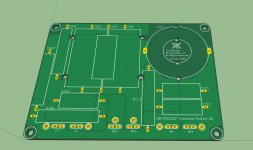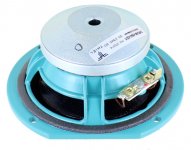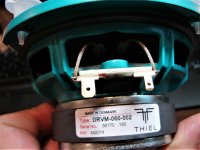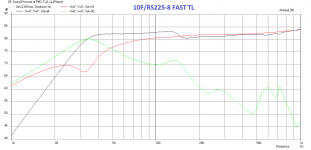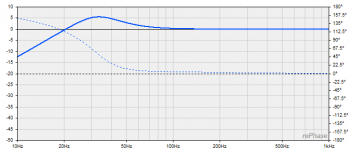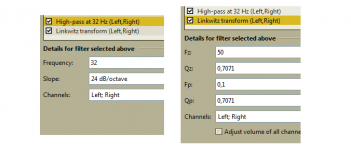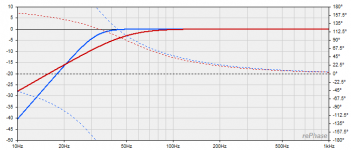Regarding the blue framed 10F, they are still on sale, X. I just ordered a pair!
And Parts Express has the RS225's on sale right now as well.
Will you be starting a GB for the XO PCB? (Looks like you beat me to it, X! Thank you!)
And Parts Express has the RS225's on sale right now as well.
Will you be starting a GB for the XO PCB? (Looks like you beat me to it, X! Thank you!)
Last edited:
Wow, all 4 drivers for $206! That’s a deal alright. Yes, I will be starting a GB thread shortly. Looks like the perfect timing to make this speaker.
RS225 at $50ea:
Dayton Audio RS225-8 8" Reference Woofer
10F at $53 ea:
THIEL 10F/8424G02 4" Fiberglass Midrange 8 ohm (DRVM-060-01)
Once could have fun with this and make the whole baffle aqua blue color. 🙂
RS225 at $50ea:
Dayton Audio RS225-8 8" Reference Woofer
10F at $53 ea:
THIEL 10F/8424G02 4" Fiberglass Midrange 8 ohm (DRVM-060-01)
Once could have fun with this and make the whole baffle aqua blue color. 🙂
Last edited:
Haha! I don't know about the aqua blue, but who knows. But yeah, what a steal for all those drivers. Too good to pass up.
A PS95-8 or RS100-8 also works very well there and both have round black bezels.
There is the 10F/8414 that is black and normally $69. That can work very well too.
Lots of options for full range drivers here. As long as they are wide band and 8ohms and at least 83dB sensitive.
There is the 10F/8414 that is black and normally $69. That can work very well too.
Lots of options for full range drivers here. As long as they are wide band and 8ohms and at least 83dB sensitive.
X, how does one do this with DSP?
With 2 sets of connectors on the box, 4 outputs from a DAC and 2 stereo amps.
🙂
With 2 sets of connectors on the box, 4 outputs from a DAC and 2 stereo amps.
🙂
What I meant was entirely with DSP no passive x/o. Is it possible? I have the 4x10.
It’s detailed in the first 20 pages of this thread as I started out with DSP. You need a pair of amps for total of 4 channels. Connect to miniDSP (you are only using 4 of 10).
You need a microphone.
You have your choice of 1st order XO like this passive. It requires some adjustment of EQ to get rid of the breakup at 7kHz.
Or use the Harsch XO - explained in detail in its own thread. It has steeper slopes on woofer but still maintains a semi transient perfect response.
S. Harsch XO
The 1st order XO is also nice and it uses more of the bandwidth of the RS225 more, and has a more refined sound - great for jazz ensembles or delicate vocals.
The DSP route takes some work to get just right - but can correct for room artifacts which is nice. The passive XO is the easiest for people who don’t want to measure and futz with software and only use one nice amp. Perfect for use with your favorite Class A amp.
You need a microphone.
You have your choice of 1st order XO like this passive. It requires some adjustment of EQ to get rid of the breakup at 7kHz.
Or use the Harsch XO - explained in detail in its own thread. It has steeper slopes on woofer but still maintains a semi transient perfect response.
S. Harsch XO
The 1st order XO is also nice and it uses more of the bandwidth of the RS225 more, and has a more refined sound - great for jazz ensembles or delicate vocals.
The DSP route takes some work to get just right - but can correct for room artifacts which is nice. The passive XO is the easiest for people who don’t want to measure and futz with software and only use one nice amp. Perfect for use with your favorite Class A amp.
The TS parameters are slightly different. But for use in this speaker it makes no difference. In fact you can use TC9FD, TG9FD, RS100-8, B80, PS95-8 etc. just adjust the attenuation resistors to match the woofer level. The 10F and TG9 and TC9 will have the smoothest response. The truncated bezel is a pain though - cutting a rebate for that is not easy. Might be easier to add a piece of crescent or arc shaped wood or plastic. That gap will cause some diffraction artifacts of not smoothed out.
Last edited:
Speaking of very enjoyable speakers, just for a well-repected reference and a very different design to compare to, I ordered some LS50s, taking advantage of the KEF recent bargain prices.
The thing is, my WAW Reference Monitors have been really singing lately. I settled on an attentuation level for the 10F/8414, returned to 4.0 mH on the RS225, improved my speaker stand situation, went with more toe-in, moved some acoustic treatment around in the room. It is simple hard for me to imagine the KEFs sounding better overall. Different, yes I'm sure of that.
Should be fun!
Hi CGodecke,
Any word on the comparison between the 10F/RS225 and the LS50's? I have heard the LS50's in a store in Darmstadt about a year ago. I did not have a side by side comparision, but do recall that they seemed to have some pretty impressive bass from the bass reflex ports. I would say that the visceral 130Hz to 300Hz midbass punch is a lot less with a 5in driver than the 8in RS225 aluminum cone Dayton. But would be interesting to hear about your listening impressions.
Nice technical review of 10F/8414:
Test Bench - Scan-Speak 10F/8414G10 Small 3.5” Full-Range Woofer | audioXpress
I really should try these out in this speaker. The new XO PCB might be a good opportunity.
Scanspeak Discovery 10F/8414G-10 4" Full Range: Madisound Speaker Components
Test Bench - Scan-Speak 10F/8414G10 Small 3.5” Full-Range Woofer | audioXpress
I really should try these out in this speaker. The new XO PCB might be a good opportunity.
Scanspeak Discovery 10F/8414G-10 4" Full Range: Madisound Speaker Components
Last edited:
Vunce was asking me if this speaker could be made into a floorstander. And I thought as long as we are doing that, why not design a tapered TL (PMC style) that will give deeper bass that is still tight and not flappy like a bass reflex. Doodling around on Akabak seems to indicate that we can still get the same sensitivity and achieve -3dB at 32Hz. That's a huge difference from the 50Hz of the sealed cabinet. But this comes at the price of a larger and more complex cabinet.
Here is the predicted freuency response of the RS225 at 1m and 2.83v (4pi space) so far:
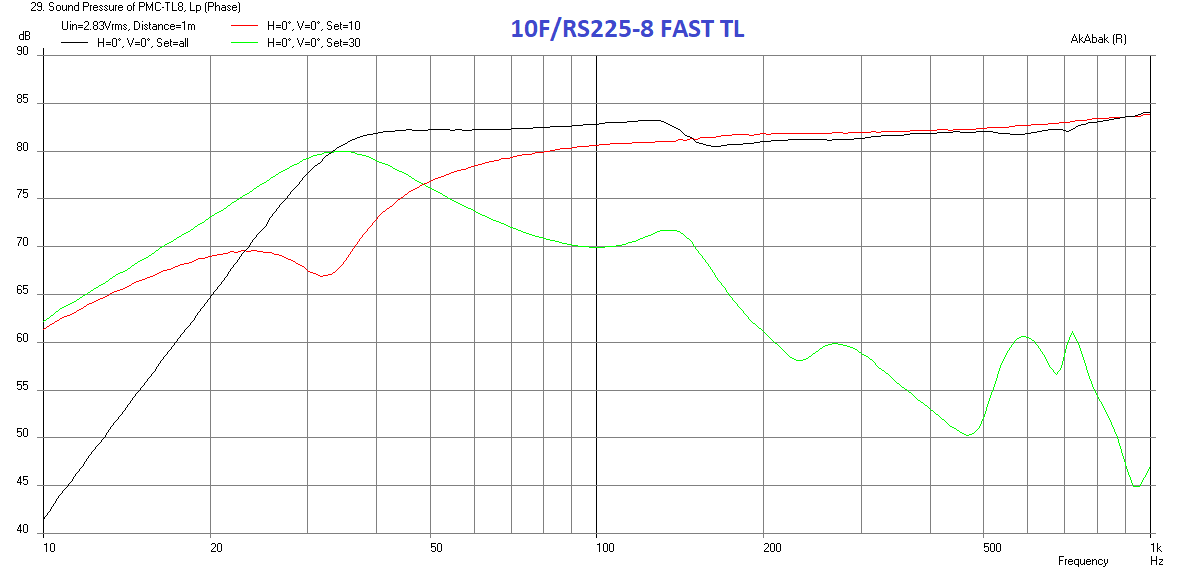
Here is the predicted freuency response of the RS225 at 1m and 2.83v (4pi space) so far:
Attachments
Hello XRK,
This is excellent. There should be a floor stander TL version always. I remember one member doing so. If you can fine tune this, it will be a nice addition to already good speaker. I am trying to do something similar for some time but cant seem to get to it.
Thanks
Balaji
This is excellent. There should be a floor stander TL version always. I remember one member doing so. If you can fine tune this, it will be a nice addition to already good speaker. I am trying to do something similar for some time but cant seem to get to it.
Thanks
Balaji
Vunce was asking me if this speaker could be made into a floorstander. And I thought as long as we are doing that, why not design a tapered TL (PMC style) that will give deeper bass that is still tight and not flappy like a bass reflex. Doodling around on Akabak seems to indicate that we can still get the same sensitivity and achieve -3dB at 32Hz. That's a huge difference from the 50Hz of the sealed cabinet. But this comes at the price of a larger and more complex cabinet.
Here is the predicted freuency response of the RS225 at 1m and 2.83v (4pi space) so far:
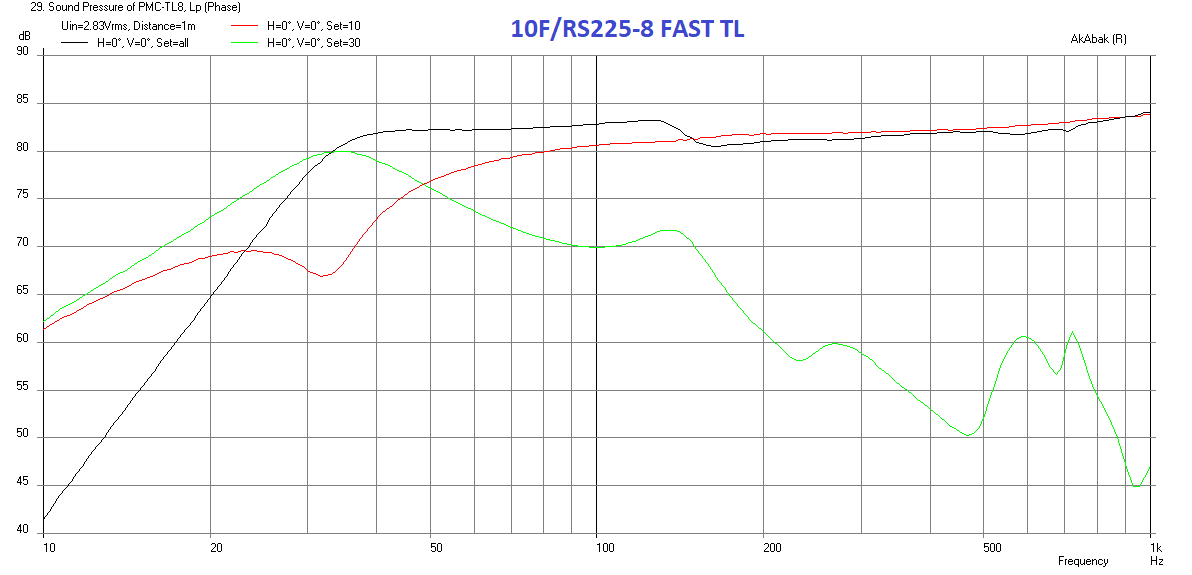
Hi X,
Would you share impedance curve for that 32Hz tapered TL simulation, you know one get curious on details of differences in objective data when sound performance is reported to be improved relative to ordinary bass reflex : )
BTW except for bragging rights or outdoor use not shure a lower roll frq number is always to the better in a real world room that normal have some real time pressurization gain plus up to six times reinforcement boundarys that could come more or less late and also include inteference nulls. That said you should be able to get a feel simulate sound at a carefull bit lower acoustic SPL those roll off differences in your own lab room using the sealed enclosures and set below cascaded filters in Jriver to transfer 2nd order @50Hz to 4th order @32.
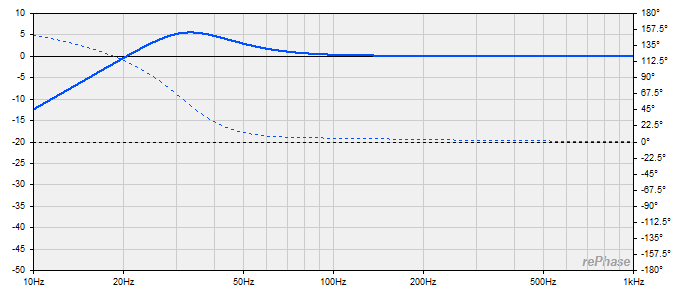
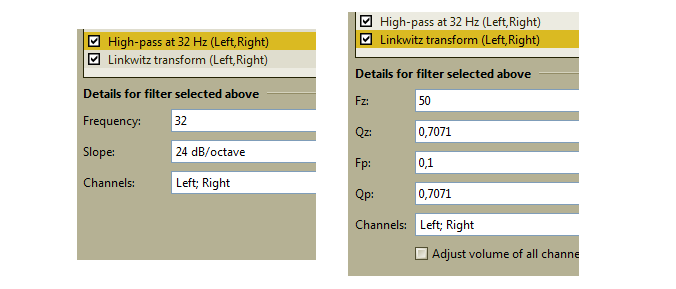
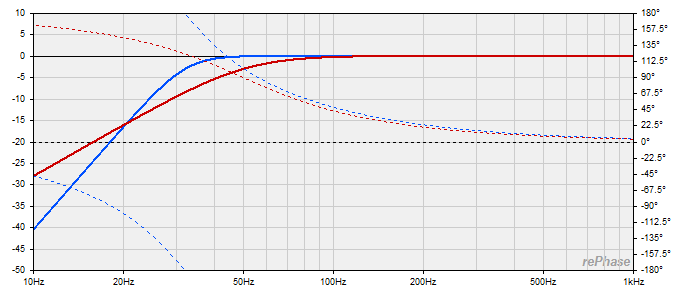
Would you share impedance curve for that 32Hz tapered TL simulation, you know one get curious on details of differences in objective data when sound performance is reported to be improved relative to ordinary bass reflex : )
BTW except for bragging rights or outdoor use not shure a lower roll frq number is always to the better in a real world room that normal have some real time pressurization gain plus up to six times reinforcement boundarys that could come more or less late and also include inteference nulls. That said you should be able to get a feel simulate sound at a carefull bit lower acoustic SPL those roll off differences in your own lab room using the sealed enclosures and set below cascaded filters in Jriver to transfer 2nd order @50Hz to 4th order @32.
Attachments
I will have to tune this in my lab to see if 32Hz makes sense. An earlier sim came up with -3dB at 38Hz and I think that might have a better presence with room gain accounted for.
Vunce was asking me if this speaker could be made into a floorstander.
This is what I want to do as well except I want BR instead of TL. My quasi RS Duet started out an MLTL (Paul K's design) and I listened to it for a while but ended up converting it to a BR. It goes very low and I don't think it's flabby at all. It just needs the level set for the RS225.
Well, fortunately, a BR is easy to design. Just keep the baffle width at 10in and driver positions the same to use the same XO. Make the box as tall and as deep as you need to achieve your BR volume. I think Atto did a BR but that was with the SB23 driver. The manufacturer recommends 1.26 cu ft for 36Hz F3.
- Home
- Loudspeakers
- Full Range
- 10F/8424 & RS225-8 FAST / WAW Ref Monitor
